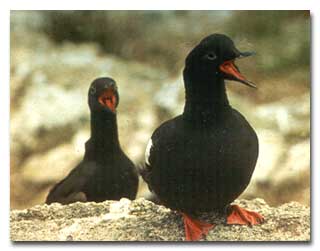Pigeon guillemot
Common Name: Pigeon guillemot
Scientific Name: Cepphus columba

Description
Guillemots are the most neritic members of the marine bird family Alcidae, which includes murres, puffins, and auks. Guillemots first breed at 2 years of age and adults have high annual survivorship. Young guillemots normally return to the natal area to breed. Nest site fidelity of breeding pairs is high and even in instances when pairs relocate nests, the distances involved are usually small(<30 m).
Eggs are laid in a wide variety of natural crevices and holes, but most nest sites in the study area are located in cavities in rock masses. Eggs are usually laid about 50 cm from the entrance of the nest crevice, thus eggs, chicks, and attending adults are frequently accessible for data collection. Guillemots are unusual among alcids in that they normally lay two-egg clutches and raise two chicks per nesting attempt. Guillemots carry whole fish in their bills to the nest-site crevice to feed their young. Thus, individual prey items can be identified, weighed, measured, and, if necessary, collected for contaminant analyses.
Bluff Nester
Pigeon guillemots nest in rocky crevices or sandy bluffs in late spring and summer. Nest sites occur on Smith, Sentinel, Flower, and Protection Islands. Nests can also be found in bluffs on the east side of Vashon, Fox, and Anderson Islands. Guillemots often seek the cover of overhanging soil and plants on high bluffs for nesting.
Pigeon guillemots dig holes in cliffs for nest sites. They use their narrow beaks to pry out stones, and sharp toe nails to scrape. Cliff nests are placed in crevices or hollows where one or two greenish, dark spotted eggs are laid.
Pigeon Guillemot Facts
- Winter White
In the winter, pigeon guillemots display a white head and mottled underparts.
- White Patch
Mature pigeon guillemots have a white wing patch while at rest or in flight; immature guillemots have a mottled wing patch. Length: About 10 ½ inches.
Sexes: look similar. Narrow, dark bill. Dark inside wings.
- Red feet and legs
- Listen for whistles
The pigeon guillemot makes high whistles near breeding bluffs in the spring.
In all seasons, pigeon guillemots can be identified by brilliant red legs and feet.
Identification Tips
- Length: 10.5 inches
- Sexes similar
- Immature like basic adult but has mottled wing patch
- Medium size alcid that dives for food from water surface
- Thin, dark bill
- Large white patch in wing visible at rest and in flight
- Small, dark wedge in white wing patch
- Dark wing linings
- Red legs and feet
- Pelagic bird only coming ashore to breed
Adult Alternate
- Entirely black plumage
Adult Basic
- White neck and underparts
- Dark areas on face
- Gray, mottled back
- Black wings and tail
Similar Species
The Pigeon Guillemot is most similar in plumage to the Black Guillemot but their ranges only overlap in Alaska. In all plumages, the Pigeon Guillemot has dark wing linings and a dark wedge intruding into the white wing patch. In breeding plumage the male White-winged Scoter is vaguely similar but has a differently shaped bill and profile, white secondaries rather than coverts, and some white on the face. Basic and juvenile plumage Marbled Murrelets are somewhat similar but lack the wing patches, have shorter necks, and smaller bills.
 Deep Sea Crabs
Deep Sea Crabs